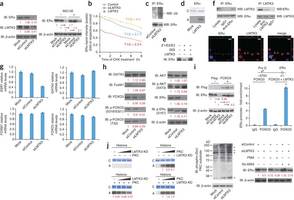英国研究人员日前宣布发现一个有助治疗乳腺癌的新靶点。动物实验显示,如能影响这个靶点,可以增强现有药物的作用,使肿瘤显著缩小。
英国帝国理工学院的贾斯廷·斯特宾教授等人在新一期英国学术期刊《自然—医学》上报告说,目前常用他莫西芬等药物来治疗乳腺癌,但许多病人的肿瘤逐渐出现耐药反应。本次研究发现,一种名为LMTK3的蛋白质在这种耐药性中发挥了重要作用。研究人员利用基因手段使实验鼠不能产生这种蛋白质,结果在治疗它们所患的乳腺癌时,药物的作用增强,使肿瘤显著缩小。
研究人员还检测了一些人类乳腺癌患者体内的这种蛋白质水平。结果发现,对于肿瘤内蛋白质LMTK3水平较高的患者,某些常规药物的疗效较弱,患者寿命更短。而因天然基因变异导致这种蛋白质水平较低的患者,往往能够活得更久。
斯特宾说,他和同事正在寻找能有效控制这种蛋白质水平的药物,估计可在5到10年内开发出安全用于人类的相关药物。
生物探索推荐英文论文摘要:
Kinome screening for regulators of the estrogen receptor identifies LMTK3 as a new therapeutic target in breast cancer
Therapies targeting estrogen receptor α (ERα, encoded by ESR1) have transformed the treatment of breast cancer. However, large numbers of women relapse, highlighting the need for the discovery of new regulatory targets modulating ERα pathways. An siRNA screen identified kinases whose silencing alters the estrogen response including those previously implicated in regulating ERα activity (such as mitogen-activated protein kinase and AKT). Among the most potent regulators was lemur tyrosine kinase-3 (LMTK3), for which a role has not previously been assigned. In contrast to other modulators of ERα activity, LMTK3 seems to have been subject to Darwinian positive selection, a noteworthy result given the unique susceptibility of humans to ERα+ breast cancer. LMTK3 acts by decreasing the activity of protein kinase C (PKC) and the phosphorylation of AKT (Ser473), thereby increasing binding of forkhead box O3 (FOXO3) to the ESR1 promoter. LMTK3 phosphorylated ERα, protecting it from proteasomal degradation in vitro. Silencing of LMTK3 reduced tumor volume in an orthotopic mouse model and abrogated proliferation of ERα+ but not ERα− cells, indicative of its role in ERα activity. In human cancers, LMTK3 abundance and intronic polymorphisms were significantly associated with disease-free and overall survival and predicted response to endocrine therapies. These findings yield insights into the natural history of breast cancer in humans and reveal LMTK3 as a new therapeutic target.

Figure 1: High-throughput siRNA screen identifies kinases modulating ERα transcriptional activity.

Figure 2: Mechanisms of LMTK3 action on ERα transcription and translation.







